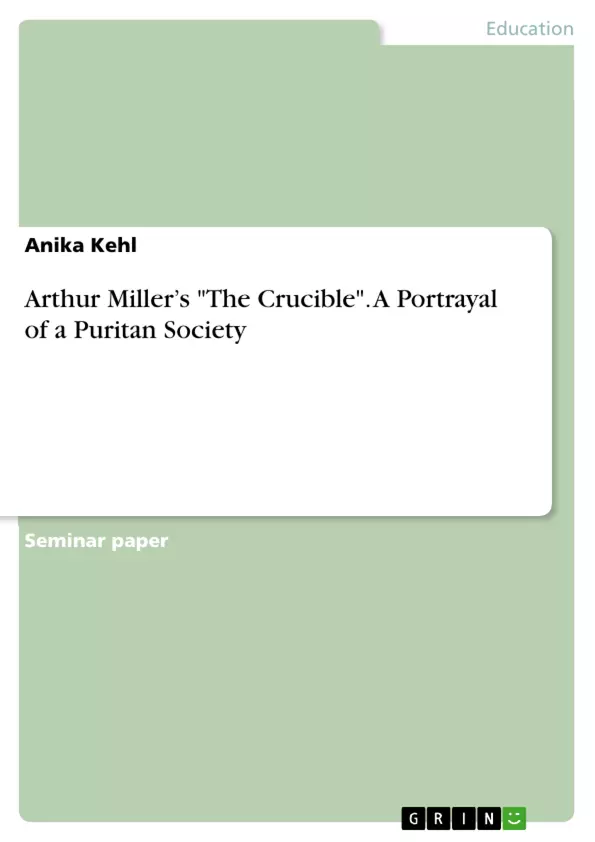What happened in Salem, in 1692, is today described as one of the darkest episodes in American history. Still today, historians try to find out what caused the disastrous outbreak of the witch craze but the only thing they can be sure about is that they can not explain why so many people had to die. “Accusations of witchcraft were not unusual in the seventeenth-century world […]” What was so special about the time and place that such an outbreak of random accusations became possible? “[…] “Salem” has become an icon in American culture. The trials have become a metaphor for hysterical prosecution, unfounded accusations, and confessions that have no reasonable explanation.” Believe in witchcraft had existed for hundreds of years before the hysteria broke out in Salem. The colonists who came to Massachusetts had a strong belief in the devil and his agents and were mainly Puritans, who came to America to gain religious freedom.
There are many things you could compare between the historical account of the witch hunt and Arthur Miller’s play The Crucible. This paper is going to analyse the portrayal of a Puritan society in Miller’s play and will try to find out whether the religion of the people and therewith their way of life have caused the rising of the witch scare and the horrible outcome for the characters in the play. It is going to be analysed why normal people start accusing their neighbours and friends for witchcraft although many of them are aware of the consequences for the accused.
At first it is going to be described how Arthur Miller informed himself about the happenings of 1692 in order to underline his credibility of being able to create the Puritan society of that time. In the following the terms ‘Puritanism’ and ‘Puritan’ will be briefly defined. The main part of the paper will concentrate on the analysis of Puritan traits, beliefs, and lifestyles in The Crucible in order to find out whether they might have played a part in the catastrophe.
Table of Contents
- Introduction
- The coming about of The Crucible
- Puritanism - Puritan
- The Puritan World in The Crucible
- Church Services
- The Bible
- Believe in the Devil and his servants
- Everybody can be a target
- Women and their link to the devil
- Oppression of personal feelings and freedom
- Clergy and Judges
- Confession
- Conclusion
Objectives and Key Themes
This paper analyzes the portrayal of a Puritan society in Arthur Miller's play "The Crucible". It aims to examine whether the religious beliefs and lifestyle of the Puritan community contributed to the rise of the witch scare and the tragic outcomes for the characters. The paper will analyze the reasons why ordinary people accuse their neighbors and friends of witchcraft, despite the consequences for the accused.- Arthur Miller's research and historical context
- Puritan beliefs and practices
- The influence of Puritanism on the Salem witch trials
- The role of fear and paranoia in the community
- The consequences of accusations and trials on individual lives
Chapter Summaries
The introduction provides background information about the Salem witch trials, outlining the historical context and the influence of Puritanism on the events of 1692. It also introduces Arthur Miller's play "The Crucible" and his approach to depicting the Puritan society. The author explores the research conducted by Miller and the sources he used to create the play.
The second chapter delves into the core aspects of Puritanism, defining the term and its impact on the lives of individuals and the community. This chapter also explores the Puritan belief system, including their views on witchcraft, the devil, and the importance of religious adherence.
The third chapter focuses on the depiction of Puritan life in "The Crucible". It analyzes specific elements such as church services, the role of the Bible, the fear of the devil, the dynamics of power and authority, and the consequences of accusations of witchcraft. The chapter explores how Puritan beliefs and practices contributed to the rise of the witch scare.
Keywords
The main keywords and focus topics of this work are: Puritanism, Salem witch trials, Arthur Miller, "The Crucible", religious beliefs, witchcraft, fear, paranoia, accusations, consequences, community, society, historical context, and individual lives. The paper delves into the influence of Puritanism on the events of the Salem witch trials and the impact of fear and accusations on the community.- Quote paper
- Anika Kehl (Author), 2010, Arthur Miller’s "The Crucible". A Portrayal of a Puritan Society, Munich, GRIN Verlag, https://www.grin.com/document/279046



